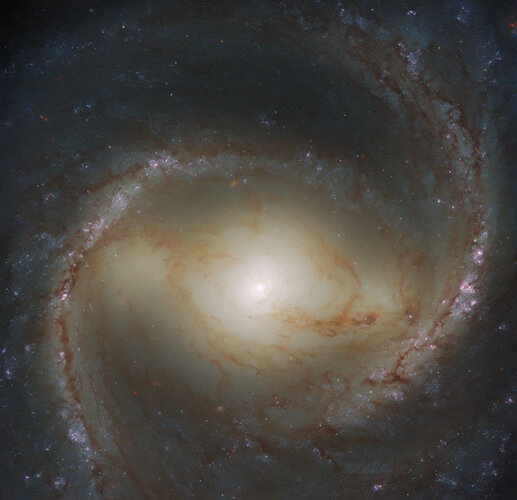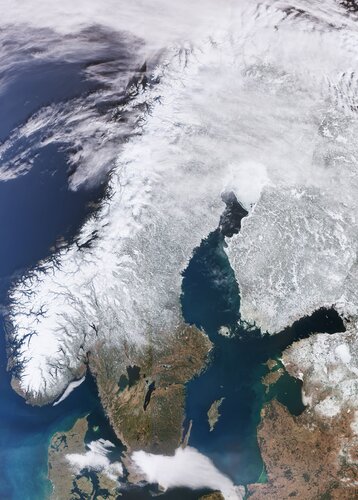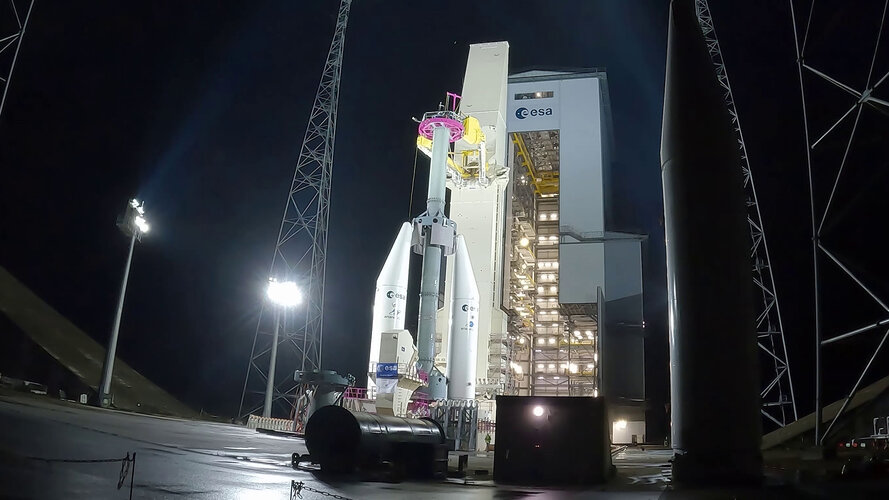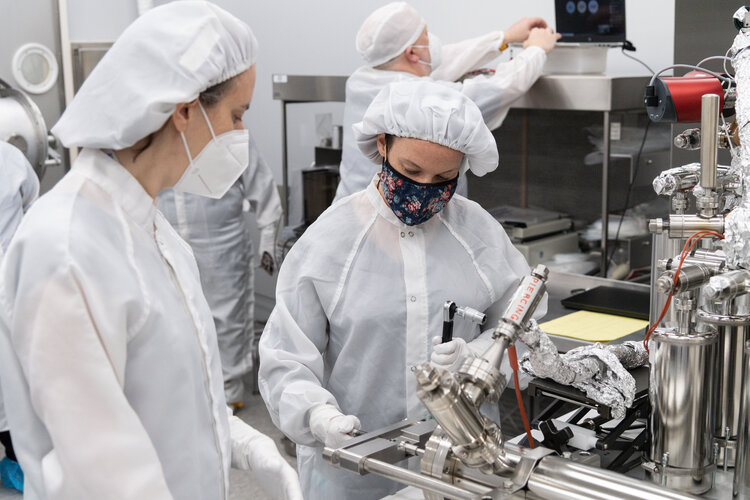
Copernical Team
Video: Ariane 6 cryo-arms test mimics liftoff

Europe's Spaceport in French Guiana is preparing for the arrival of Ariane 6, ESA's new heavy-lift rocket. The latest round of testing aims to validate the system of fuel lines and mechanical supporting arms that will keep Ariane 6 topped up with liquid hydrogen and liquid oxygen in the critical moments before liftoff. This work is part of the final preparations of the new Ariane 6 launch complex and all the systems necessary for a launch.
With the mobile gantry fully retracted—as for a launch—two articulated arms attached to the upper part of the Ariane 6 mast on the launch pad were separated and retracted while filled with hydrogen that is cooled to its liquid state at cryogenic temperatures. This maneuver mimics the seconds before liftoff.
The "cryo-arms" are part of the fluidic connection system which connects to Ariane 6 in the final countdown to launch. They support the upper umbilicals which supply cryogenic top-up fuel, maintain the correct pressurization of the tanks, cool the engines before ignition and generally keep the upper stage in an optimal condition right up to the point of liftoff.
Week in images: 11-15 April 2022

Week in images: 11-15 April 2022
Discover our week through the lens
Earth from Space: Scandinavian Peninsula

The Copernicus Sentinel-3 mission captured this impressive shot of the almost cloud-free Scandinavian Peninsula on 20 March.
Divide and conquer: Mars rovers could be superseded by swarms of two-wheeled robots

Skoltech scientists have proposed a concept for a modular Mars exploration rover. Leveraging the power of cooperative robotics, the new system first described in an Acta Astronautica paper consists of four two-wheeled robots that can operate independently or combine in various constellations. According to the study, that approach will enable longer exploration missions that gather more information about the planet's history, potential habitability, and possible traces of surface water or prior life.
Since NASA's Pathfinder, the first successful Mars rover, landed on the Red Planet in 1997, researchers have used the same basic design: a six-wheeled autonomous exploratory vehicle carrying a set of scientific instruments on board. Nowadays, researchers suggest that a Mars mission could accomplish more in the same timespan if it consists of several variously equipped robots simultaneously carrying out separate tasks at different locations and occasionally coming together for more challenging tasks.
"This is basically an optimization problem: How do you maximize exploration time and distance covered without driving the cost of the mission through the roof?" Skoltech Ph.D.
Fuel leak thwarts NASA's dress rehearsal for moon rocket

NASA's latest attempt to fuel its huge moon rocket for a countdown test was thwarted Thursday by a hazardous hydrogen leak, the latest in a series of vexing equipment trouble.
Plasma ejections from the sun could cause damage on Earth, scientists say
 An unusual magnetic storm from the sun will aim at the Earth soon, possibly beginning Thursday, and experts say it has the potential to cause some noticeable damage here on our planet.
Scientists say that the solar activity - called a geomagnetic storm - will produce a magnetic discharge and send it in the direction toward Earth. In other words, essentially, that means that increased
An unusual magnetic storm from the sun will aim at the Earth soon, possibly beginning Thursday, and experts say it has the potential to cause some noticeable damage here on our planet.
Scientists say that the solar activity - called a geomagnetic storm - will produce a magnetic discharge and send it in the direction toward Earth. In other words, essentially, that means that increased Ariane 6 cryo-arms mimic liftoff
 Video:
00:01:24
Video:
00:01:24
Europe’s Spaceport in French Guiana is preparing for the arrival of Ariane 6, ESA’s new heavy-lift rocket. The latest round of testing aims to validate the system of fuel lines and mechanical supporting arms that will keep Ariane 6 topped up with liquid hydrogen and liquid oxygen in the critical moments before liftoff. This work is part of the final preparations of the new Ariane 6 launch complex and all the systems necessary for a launch.
With the mobile gantry fully retracted – as for a launch – two articulated arms attached to the upper part of the
Industry Space Days 2022: join Europe’s space community at ESA/ESTEC

Register now to attend ESA’s Industry Space Days (ISD) at the European Space Research and Technology Centre (ESTEC) in Noordwijk, the Netherlands, on 28–29 September 2022.
Pop goes the Moon
 Image:
Image:
A satisfying, audible ‘pop’ marked a successful piercing of the sealed Apollo 17 sample container using the ESA designed and built piercing tool. The tool forms part of a gas sampling system with a gas extraction manifold, designed and built by Washington University St Louis, USA.
Francesca McDonald, science and project lead of ESA’s contribution to the Apollo Next-Generation Sample Analysis (ANGSA) programme, is pictured at the centre of this image with the piercing tool, which contains the pristine sample.
Francesca and colleague, Timon Schild, delivered the ESA piercing tool to NASA’s Johnson Space Center in late 2021 in preparation
Join online: Earth Observation Industry Day 13 May

Earth Observation Industry Day
Join online and learn about ESA's Ministerial Council plans for TRUTHS and FutureEO, 13 May

